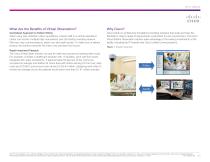
Catalog excerpts

Virtual Patient Observation What Is the Value of Virtual Patient Observation? The Cisco Virtual Patient Observation solution provides a centralized approach to patient sitting that can help improve the workflow for care providers, resulting in increased efficiency, staff satisfaction, and staff safety. It can also help improve the patient, family, and visitor experience in the hospital. Reference Figure 1 for a solution overview. ® What Problems Does It Help Solve? Patient Sitters: Important but Unreimbursed Service Healthcare facilities need to monitor patients who are at risk for falls, on suicide watch, or confused or agitated. To address this need, the solution up to this point has been to hire sitters to be physically present in the patient’s room to notify care staff when the patient engages in potentially self-injurious behavior. These sitters are generally paid by the hour, reflecting an unreimbursed expense for the hospital. Alternatively, some healthcare facilities must ask the patient’s family to provide a sitter, imposing a burden for working family members, or they might charge the family for the service. Scalability and Scheduling The need to schedule a physical sitter for each patient who requires coverage creates a scheduling burden on the hospital. In addition, it can be more difficult to quickly add sitting services for a patient without affecting patient care in other areas. Often an on-duty nursing aide is pulled from duties elsewhere until a dedicated person can be brought in as the temporary sitter. Cisco Virtual Observation The Cisco Virtual Observation solution builds on the Cisco Physical Security architecture and Cisco Video Surveillance solutions to lower costs and help hospitals improve patient safety. It includes video surveillance cameras, monitoring software, and twoway communications, with all of this building on the underlying Cisco network as the core foundation. Video Monitoring The solution uses Cisco Video Surveillance IP Cameras mounted in patients’ rooms to capture video. The live video feeds travel over the facility’s existing LAN/WAN to a Cisco Video Surveillance Manager (VSM) server in the operations center. The video is not recorded, so the only Health Insurance Portability and Accountability Act (HIPAA) requirement is to make sure that images and audio can only be seen or heard in restricted areas by authorized individuals. When patients or healthcare providers want privacy, they use the same methods they would use if a physical sitter were present, such as pulling the curtain. Optionally, hospitals that already use the Cisco Physical Access Control system can install badge readers in patient rooms where healthcare providers can present their badge to turn the cameras on and off. The advantage of this automation is that all of the information is logged if future investigation is needed. Video Analytics and Integration with In-Room Sensors Healthcare facilities can optionally enable the built-in motion detector on the Cisco cameras. When motion is detected, an alert is sent to the console to give virtual sitters yet another indication that a patient might be engaging in behavior that puts the patient at risk, such as attempting to get out of bed without assistance. Motion alerts do not replace visual monitoring, but they give sitters an additional cue that a situation requires closer monitoring. Another option is to use video analytics software that detects loitering to alert the virtual sitter when a patient moves out of a defined area. Facilities can also integrate the Cisco Virtual Sitter solution with electronic “tripwires” or bed sensors, sending an alert to the sitter’s dispatch console when these sensors are activated. Two-Way Communications with Healthcare Providers A trained sitter in the operations center can communicate with staff on the patient’s floor using the Cisco IP Interoperability and Collaboration System (IPICS) Dispatch Console. IPICS is an endto-end dispatching solution designed for critical communications. It can alert staff in multiple ways, including direct calls to wireless IP phones, twoway communications using push-to-talk radios, text messaging to smartphones, and prerecorded messages sent to IP phones or overhead paging systems. Also, integration can be done with nurse call systems, enabling operations center staff to remotely activate the appropriate color for the over-door lighting. © 2013 Cisco Systems, Inc. and/or its affiliates. Cisco and the Cisco logo are trademarks or registered trademarks of Cisco and/or its affiliates in the U.S. and other countries. To view a list of Cisco trademarks, go to this URL: www.cisco.com/go/trademarks. Third party trademarks mentioned are the property of their respective owners. The use of the word partner does not imply a partnership relationship between Cisco and any other
Open the catalog to page 1
What Are the Benefits of Virtual Observation? Centralized Approach to Patient Sitting When using high-definition video surveillance, trained staff in a central operations center can monitor multiple high-risk patients over the facility’s existing network. With two-way communications, sitters can alert staff quickly. To make sure of patient privacy, the solution transmits live video only and does not record. Cisco builds on architecture foundations providing solutions that scale and have the flexibility to meet a range of requirements customized for your environment. The Cisco Virtual...
Open the catalog to page 2All Cisco Systems catalogs and technical brochures
-
Webex® Board 55S
14 Pages
-
Webex® Board
14 Pages
-
Webex® Desk Pro
14 Pages
-
Webex® Desk
14 Pages
-
Webex Desk Camera
9 Pages
-
Cisco Spark Board 70
7 Pages
-
Cisco Spark Board 55
7 Pages
-
Cisco HyperFlex HX220c M4
5 Pages
-
Cisco HyperFlex HX240c M4
5 Pages
-
Healthcare Contact Center
2 Pages




















